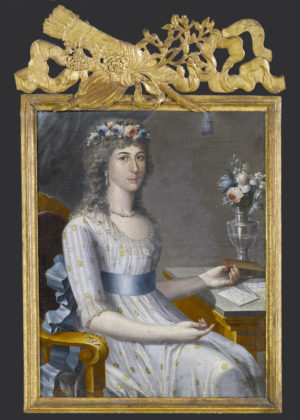
José Campeche, Doña María de los Dolores Gutiérrez del Mazo y Pérez, c. 1796, oil on canvas, 83 x 66 cm (without frame) (Brooklyn Museum)
As Puerto Rico’s most sought-after painter in the late 18th and early 19th century, José Campeche y Jordán holds an important and singular space in the art history of the Spanish Caribbean. Eighteenth-century Puerto Rico had few artists working on its shores and if you ordered works from other Spanish colonies or mainland Spain, they could take years to arrive. His production filled a niche in the local art market.
Campeche’s work can be divided into two genres: religious painting and portraiture. His work adorned many places of worship, and his portraits were commissioned by San Juan’s elite. His religious work was in demand from private clients and the Church, both within Puerto Rico and in other Spanish territories like Venezuela. As a portraitist he was sought after for both easel paintings and miniatures. Campeche’s skills responded to and were embraced by a clientele hungry for images of religious devotion and of themselves.
The artist’s development
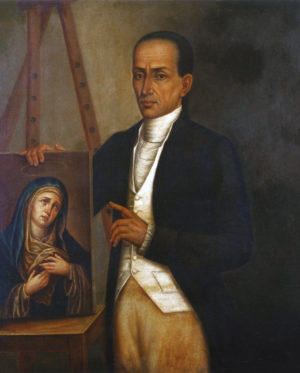
Ramón Atiles, 19th-century copy of José Campeche’s Self-Portrait, oil on canvas, 122.5cm x 102.5 cm (Carmen Ana C. de Unanue Collection)
Campeche was born in San Juan in 1751, the son of a formerly enslaved Black man and a working-class white woman from the Canary Islands. He had few options for an artistic education in Puerto Rico, as there were no art schools and few professional painters offering private instruction. Campeche also never traveled abroad. It is likely he learned the basics of his profession in his father’s workshop. Tomás Campeche was a gilder and a modest painter himself, and his workshop often produced works and did repairs for the churches in the city. Other crucial resources for Campeche’s education were imported prints of European artworks, as well as the basic instruction available to him at Church and during his studies in the Santo Tomás Convent, where general studies were established as well as studies in theology and philosophy.
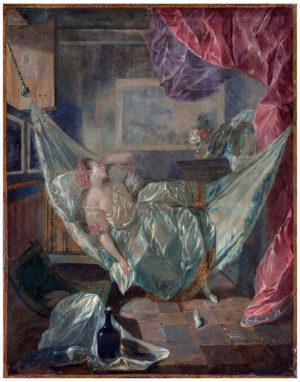
Luis Paret y Alcázar, Young Woman asleep in a Hammock, 1780–81, oil on copperplate, 19 x 15 cm (Prado Museum)
Campeche was already a professional painter at 26 when Spanish artist Luis Paret y Alcázar arrived, exiled to Puerto Rico by King Carlos III in 1775. While the details of the two artists’ possible acquaintance are not known, there is a marked change in Campeche’s work after Paret’s stay in the territory, which points to a possible interaction between the two. Paret studied with French artists in Madrid and was deeply familiar with the Rococo style, noticeable in his pastel color palette and subject matter, with works centered around court life, portraiture, and sensuous genres or allegorical compositions.
While very few of Paret’s works from his time in Puerto Rico survive, his painting known as Young Woman asleep in a Hammock gives us an idea of what Campeche could have seen. In this dreamy interior scene, a woman almost seems to be sliding from the hammock as she rests. The work has a jewel-like quality. The shining cloth of her dress drapes over her body, revealing one of her breasts. The interior space is carefully rendered with attention paid to the furnishing and objects, bathed in a hazy light that bounces from the sumptuous drapes and the cloths spread around the composition.
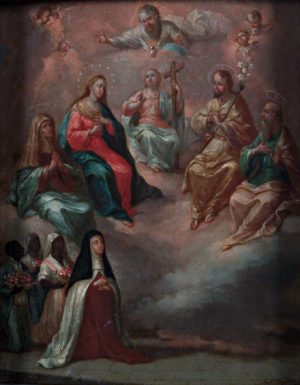
José Campeche, Exvoto de la Sagrada Familia, late eighteenth century, oil on wood, 25.6 x 20.4 cm (San Juan, Puerto Rico, Colección Instituto de Cultura Puertorriqueña)
Many of these elements are present in Campeche’s later work, such as his attentiveness to cloth and the detailing of interior spaces. Pastel tones began to dominate the celestial realm in his religious paintings, moving away from the darker palette of his earlier works and which was stylistically connected with his counterparts throughout the Spanish viceroyalties.
These changes are also present in his portraits, especially his female portraits, such as one showing Maria Catalina de Urrutia. While mostly adhering to the compositional conventions of portraiture in continental Spanish America, here, Campeche leans toward bright and pastel colors, and elaborate detailing of the spaces and clothes that add a sense of luxury that convey more Rococo sensibilities. In his portraits, sitters often wear military uniforms and French inspired fashions, such as fine fabrics, ribbons, and lace combined with a powdered hair or wig. [1]

José Campeche, Miguel Antonio de Ustariz, 1789–92, oil on canvas, 60 x 41.5 cm (Instituto de Cultura Puertorriqueña)
The chronicler of San Juan society
The artist painted the who’s who of San Juan—governors, bishops, captains, mayors, colonial administrators, and their families posed before Campeche’s easel. In these portraits, he included references to their accomplishments, education, and positions. This is something common in 18th-century portraiture in colonial Latin America, where inscriptions or cartouches and coats of arms were often added to communicate the sitter’s titles and family relations.
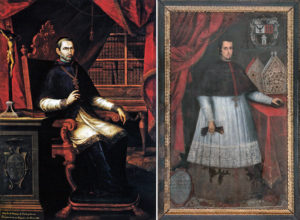
Left: José Campeche, Bishop Francisco de la Cuerda, c. 1791–92, oil on canvas (Palacio Arzobispal de San Juan collection); right: Unidentified artist, Luis Francisco Romero, Bishop of Santiago de Chile and of Quito, 1718, oil on canvas, 88 x 56 1/3” (Museo del Carmen de Maipú, Santiago, Chile)
His 1792 portrait of Bishop Francisco de la Cuerda is not dissimilar to that of the 1718 portrait of Luis Francisco Romero, Bishop of Santiago de Chile and Quito. Both have a dark color palette, inscriptions noting when they took over their respective offices, coats of arms, and sumptuous curtains. In Cuerda’s portrait, the drape reveal shelves of books, alluding to his intellectual interests. This type of composition is inspired directly by official portraits of Spanish monarchs that were sent to and copied in the colonies.
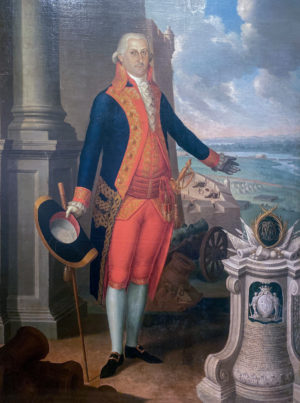
José Campeche y Jordán, Portrait of Governor Ramón de Castro, 1800, oil on canvas, 165.1 x 228.6 cm (Museo de San Juan, San Juan; photo: Tamara Díaz Calcaño)
Campeche often opted for subtle ways to add the desired information about a sitter. Coats of arms are painted as part of objects or furniture; his cartouches, often containing the names and titles of his sitters, are pieces of paper placed on desks or on the floor. At times Campeche references the accomplishment of his sitters more directly, as seen in Governor Ramón de Castro’s portrait. Along with an inscribed plinth in the right foreground, Campeche added a view of the territory and fortress that the governor used to defend San Juan from the British in 1797.
An important and distinctive element of Campeche’s portraiture is the inclusion of images that indicate the Caribbean as the setting of the composition. These markers of place are part of a developing visual culture that seeks to identify what is distinctively Puerto Rican. For example, the artist included Puerto Rican objects, fruits, plants, or landscapes, such as we see with the inclusion of San Juan in the portraits of Miguel Antonio de Ustariz and Governor Ramón de Castro.

José Campeche, The Daughters of Governor Ramón de Castro, 1797, oil on canvas, 31.75 x 45.38 inches (Museo de Arte de Puerto Rico)
In 1797, Campeche worked on a double portrait of Governor Castro’s daughters. The girls, María Guadalupe Josefa and María del Carmen, wear matching white dresses with different colored ribbons and shoes. They inhabit an interior space with landscape paintings, gilded furnishings and frames, and rose-tone curtains. The color palette is bright and delicate, and combined with the elaborate interior Campeche creates an elegant and refined painting. A paper on the floor serves as the inscription where the artist identifies the girls, their ages, and their parents.
While both girls hold unto a bundle of flowers between them, the oldest also holds an intricately carved maraca like it was a child’s rattle, possibly made of the husk of the Higuera fruit. [2] A pineapple lays in the foreground on the lower left corner. Both the maraca and the pineapple act as indicators of place, the first being an instrument typical of local music and the latter a South American fruit, cultivated in the Caribbean and so became representative of the region.
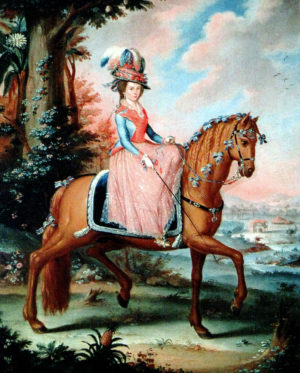
José Campeche, Dama a Caballo, late 18th century, oil on wood, San Juan, Puerto Rico (private collection)
In one of his female equestrian portraits, Campeche also used plants and structures associated with the region. This work showcases a lady and her horse posing together outside, with a pineapple plant in the foreground and a banana tree in the middle ground. In the background are two buildings associated with plantations and the countryside, a two-story structure with a section on stilts and a sugar mill with a straw roof. Rococo influences are aplenty—the hazy landscape, the dominating pastel palette, the unknown sitter’s riding dress, and even the horse’s sweet bows. Campeche painted several of these equestrian portraits, though only three are known to survive. These are fascinating paintings, in part because equestrian portraits are rare in the Spanish Americas. Their creation alludes to the strong equestrian culture in Puerto Rico, which serves as yet another marker of cultural distinction. These details set this portrait firmly in Puerto Rico and the Caribbean.
In the late 18th century, a distinct cultural identity was manifesting itself in Puerto Rico. It would continue to grow and change in the 19th century. As small as these details may be in Campeche’s paintings, they point toward that identity or a recognition of it, of belonging in some way to that place and seeking to be associated with it through these symbols. Campeche and his sitters allow us a glimpse of this through their carefully crafted images.
Notes:
[1] Vidal, Teodoro. Retratista de una época (San Juan: Ediciones Alba, 2005): p. 52.
[2] Taylor, René. Campeche y su tiempo (Ponce: Museo de Arte de Ponce, 1988): p. 183.
Additional resources
Arturo Dávila, José Campeche: Testigo de la Ciudad (San Juan Instituto de Cultura Puertorriqueña, 2005).
Arturo Dávila, Campeche: Mito y realidad (San Juan: Museo de arte de Puerto Rico, 2010).
René Taylor & Marimar Benítez, eds., Campeche y su tiempo (Ponce: Museo de Arte de Ponce, 1988).
René Taylor, “José Campeche (1751-1809)”, Puerto Rico: Arte e identidad (San Juan: Editorial de la Universidad de Puerto Rico, 2004): pp. 17–27.
Teodoro Vidal, Retratista de una época (San Juan: Ediciones Alba, 2005).


